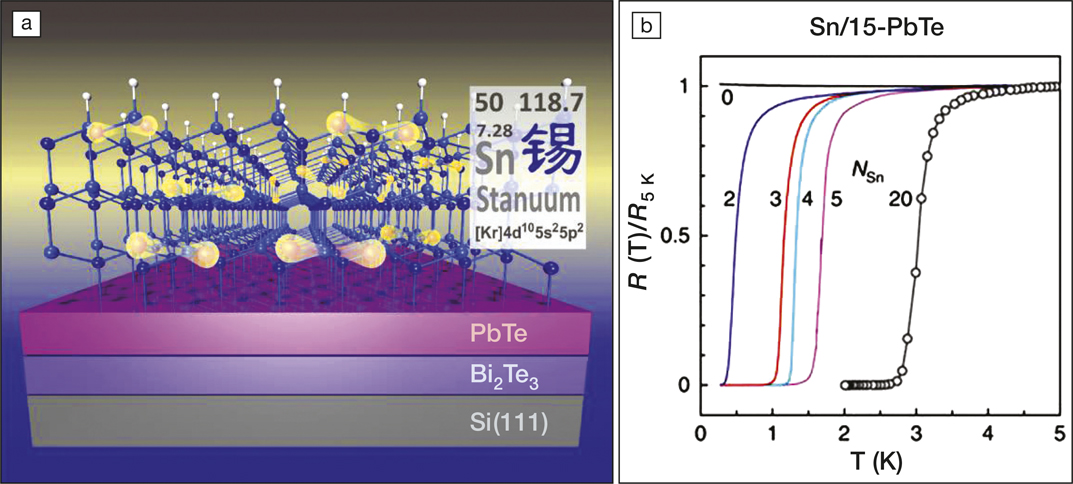Superconductivity has been applied in modern quantum computations and for no-energy-loss electricity transmission and magnetic levitation trains. To expand the toolbox of superconductors, Qi-Kun Xue of Tsinghua University and the Collaborative Innovation Center of Quantum Matter in Beijing, China, and co-workers from the Beijing institutions, RIKEN, and Stanford University have now reported that few-layer stanene, the atomically thin α-Sn sheets, exhibits superconductivity at temperatures below 3 K.
This discovery was unexpected according to Ding Zhang, an assistant professor at Tsinghua University, one of the corresponding authors of the published work in Nature Physics (doi:10.1038/s41567-017-0031-6). “Our co-authors, Prof. Yong Xu at Tsinghua University and Prof. Shoucheng Zhang at Stanford University, predicted that stanene could host the room-temperature quantum spin Hall effect, and we set [about] to look for this effect by the low-temperature magneto-transport technique,” Zhang says. “Instead, we found superconductivity.”
The material investigated, which led to the discovery, possesses a “sandwich” structure consisting of a stanene top layer, a PbTe structure buffer layer, a Bi2Te3 topological insulator layer, and a single-crystalline silicon bottom substrate.
Experimental results showed that the temperature at which superconductivity emerges is strongly correlated to the number of layers of tin. The superconductivity did not occur for the single-layer sample but appeared in the bilayer sample. Further, the transition temperature scaled with the inverse of the number of layers. In addition, the researchers observed that the thickness of the underlying buffer layer, PbTe, could also change the transition temperature. This observation was ascribed to the proximity effect of stanene and PbTe, which resulted in electron doping from PbTe and release of lattice strain of stanene. The evolution of the stanene’s electronic band structure with increasing number of layers of PbTe was also studied.

(a) A schematic illustration of the stacked materials used in this study. The top layers composed of blue spheres (tin atoms) are stanene terminated with hydrogen atoms (white spheres). The pairs of orange spheres represent Cooper pairs (electron pairs endowing superconductivity). The inset panel includes the Chinese character for “tin.” Credit: Ding Zhang, Tsinghua University and the Collaborative Innovation Center of Quantum Matter in Beijing, China. (b) The relationship between electrical resistance of stanene and the number of tin layers as a function of temperature. The number of layers of PbTe and Bi2Te3 were fixed to be 15 and 5, respectively. Credit: Nature Physics.
The researchers found that the superconductivity of stanene is remarkably stable. It showed little decay after exposure in air for as long as one year.
Yoshi Iwasa of The University of Tokyo, Japan, says that the measurement of the electrical resistance of monolayer stanene is difficult due to its unstable nature. “The authors succeeded in fabricating stanene sheets on a semiconductor substrate (PbTe) and stabilized them by hydrogen termination, leading to their discovery of superconductivity,” Iwasa says. “This paper shows that interface engineering is extremely powerful for making topological materials.” Fuchun Zhang of the Kavli Institute for Theoretical Sciences at the University of Chinese Academy of Sciences says that this work is “potentially significant to realize the in-plane integration of superconductors and 2D [two-dimensional] topological insulators, which lays the foundation of making building blocks for topological quantum computing.” Both researchers were not involved in this study.
This work offers vast opportunities for further investigations of this graphene analogue. According to Ding Zhang, the research team is moving forward to elucidate the interplay between magnetic field strength and superconductivity, to reveal the change in electronic properties by intentional electron doping, and to gain a more fundamental understanding of the proximity effect involving stanene and its supporting substrates.




